This jazz guitar chord dictionary is a reference to help you find great-sounding 7th-chord voicings to play and improvise over jazz standards. The 244 chord shapes on this page are essential knowledge for any jazz guitarist and will help you to comp chords with creativity, confidence, and variety.
Now, you don’t have to learn all of these chords at once. Instead, use this page as a resource that you come back to each time when you need to add a new chord to your vocabulary.
Have fun with these chords, get them under your fingers, and most importantly, apply them to jazz standards and chord progressions as soon as you can.
PS: If you are new to jazz guitar, check out these basic jazz guitar chords first.
CHORD TYPE LIST
- How To Read Chord Diagrams
- Basic Chords
- Shell Chords (aka Guide Tone Chords)
- Chords With Extensions
- Dominant Chords Altered Extensions
- Inversions
- Major 7 Inversions (Drop 2) – A-String Bass Note
- Major 7 Inversions (Drop 2) – D-String Bass Note
- Major 7 Inversions (Drop 3) – E-String Bass Note
- Major 7 Inversions (Drop 3) – A-String Bass Note
- Dominant 7 Inversions (Drop 2) – A-String Bass Note
- Dominant 7 Inversions (Drop 2) – D-String Bass Note
- Dominant 7 Inversions (Drop 3) – E-String Bass Note
- Dominant 7 Inversions (Drop 3) – A-String Bass Note
- Minor 7 Inversions (Drop 2) – A-String Bass Note
- Minor 7 Inversions (Drop 2) – D-String Bass Note
- Minor 7 Inversions (Drop 3) – E-String Bass Note
- Minor 7 Inversions (Drop 3) – A-String Bass Note
- Minor 7b5 Inversions (Drop 2) – A-String Bass Note
- Minor 7b5 Inversions (Drop 2) – D-String Bass Note
- Minor 7b5 Inversions (Drop 3) – E-String Bass Note
- Minor 7b5 Inversions (Drop 3) – A-String Bass Note
- Open Voicings
- Quartal Chords
- More Guitar Chord Lessons
How to Read Chord Diagrams
A red circle represents the root (aka 1) of the chord. Most chords in this dictionary have a C root.
The black circles are the other notes of the chord. The numbers inside the black circles indicate the chord tone.
The numbers (1, 2, 3, and 4) at the right side of each chord diagram indicate which fingers to use to fret the chord.
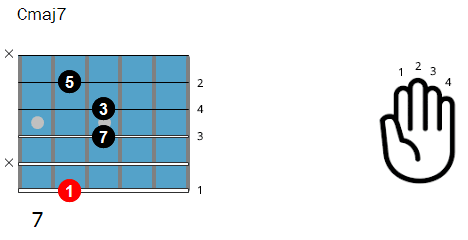
The X symbol at the left side of the chord diagram indicates that those strings are not to be played. This means that most of the chords on this page cannot be strummed, but should be played fingerstyle, with your thumb and first 3 fingers of the right hand.
The O symbol at the left side of the chord diagram indicates that those strings are played open.
Movable Chords
Most of the chords on this page are of the movable type (not the open chords though). By moving the chord shapes up or down the guitar neck, you get other chords of the same chord type.
For example: move the chord shape of a Cmaj7 vocing 2 frets higher and it becomes a Dmaj7 voicing.
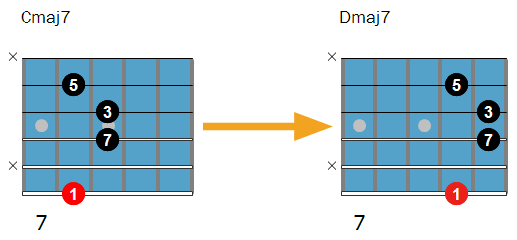
1. Basic Jazz Guitar Chords
The first group of jazz chords is called “basic”, but they should really be described as “essential”.
These shapes contain both drop 2 and drop 3 chords in root position, which is the best place to get started playing jazz guitar chords.
You will learn smaller shapes in the next section, which are easier to play, but these four-note shapes drill the sound of jazz into your ears better than the smaller shapes.
Start by learning one shape for each chord type then take those changes to a jazz tune you know or are working on.
Here are 10 great songs to practice and apply these chords to:
- Autumn Leaves
- Summertime
- All The Things You Are
- Fly Me To The Moon
- Blue Bossa
- There Will Never Be Another You
- Georgia On My Mind
- Take 5
- The Girl From Ipanema
- My Funny Valentine
Major 7 Chords
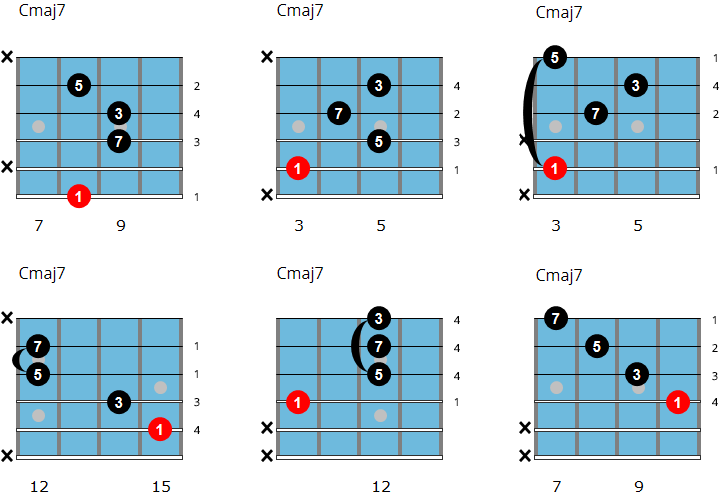
Dominant 7 Chords

Minor 7 Chords
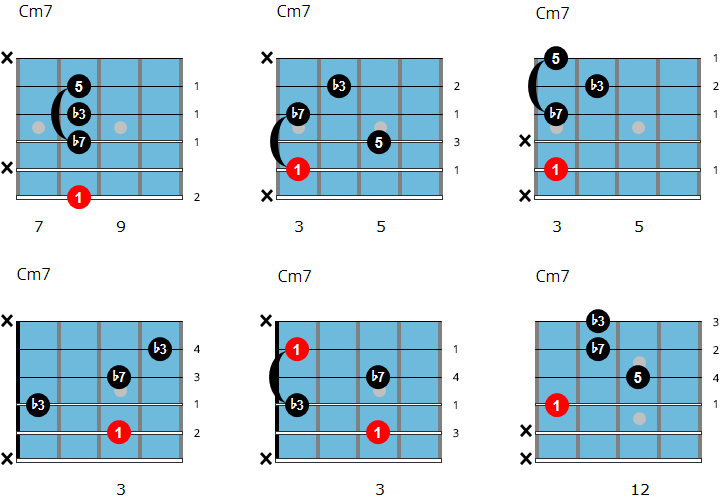
Minor 7b5 (Half-Diminished) Chords
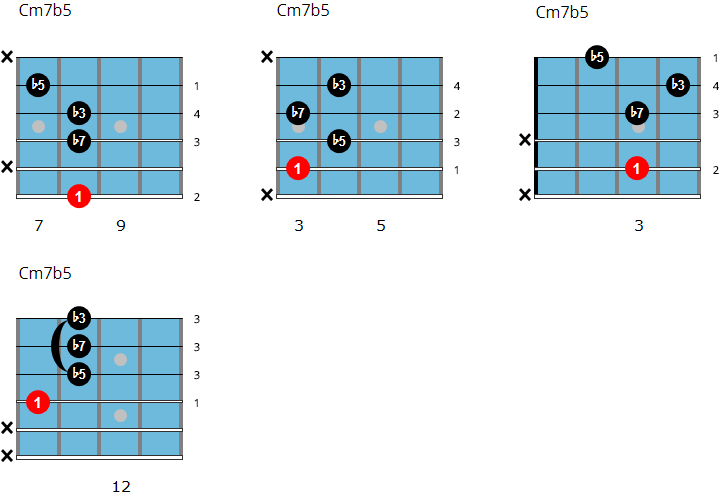
Diminished 7 Chords
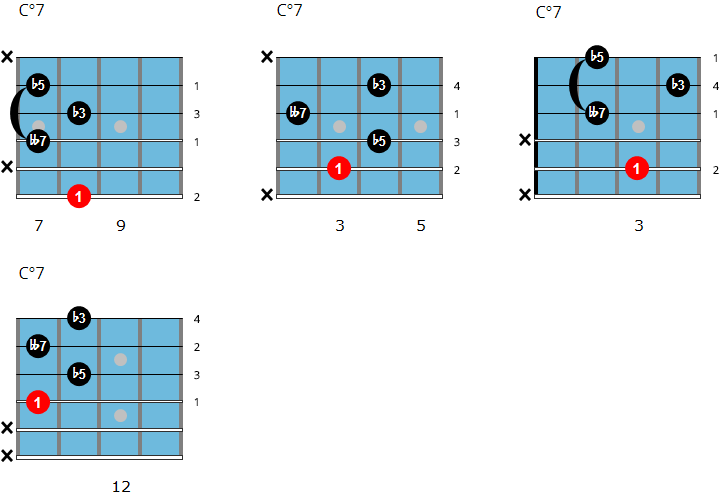
2. Shell Chords
Shell chords (aka guide tone chords) are often referred to as Freddie Green chords, as he used them to create his iconic rhythm sound with the Count Basie band.
These three-note chords contain the root, 3rd, 7th (or the 6th) of each chord.
Because of this, you hit the essential chord tones for each shape, and mostly on the lower string sets.
Since these shapes are lower on the neck than other chord shapes, you need to keep your tone in mind so you don’t clash with the bass player in your playing.
With a soft tone, these chords are highly effective when comping in a duo, trio, or larger ensembles.
1 3 7 Shell Chords (E-String Root)
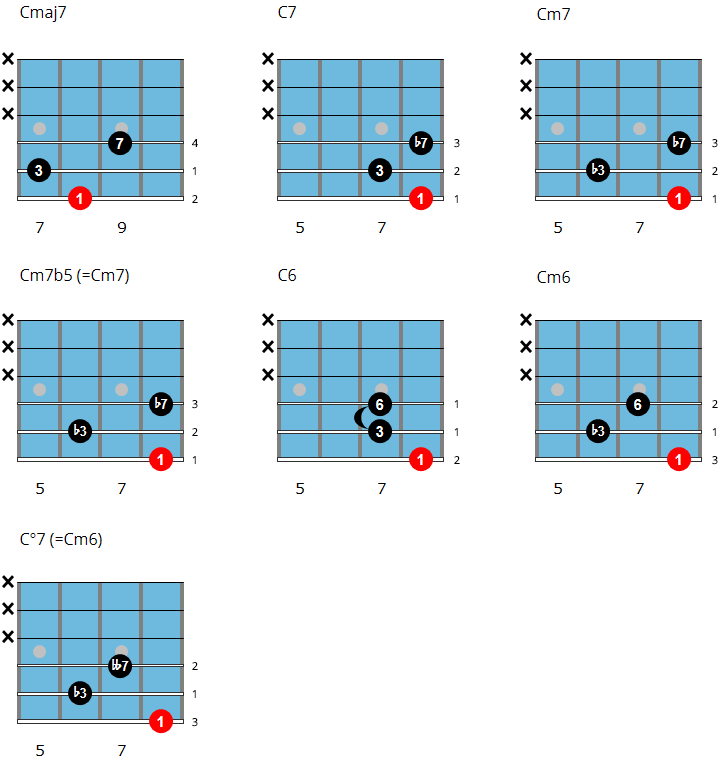
1 7 3 Shell Chords (E-String Root)
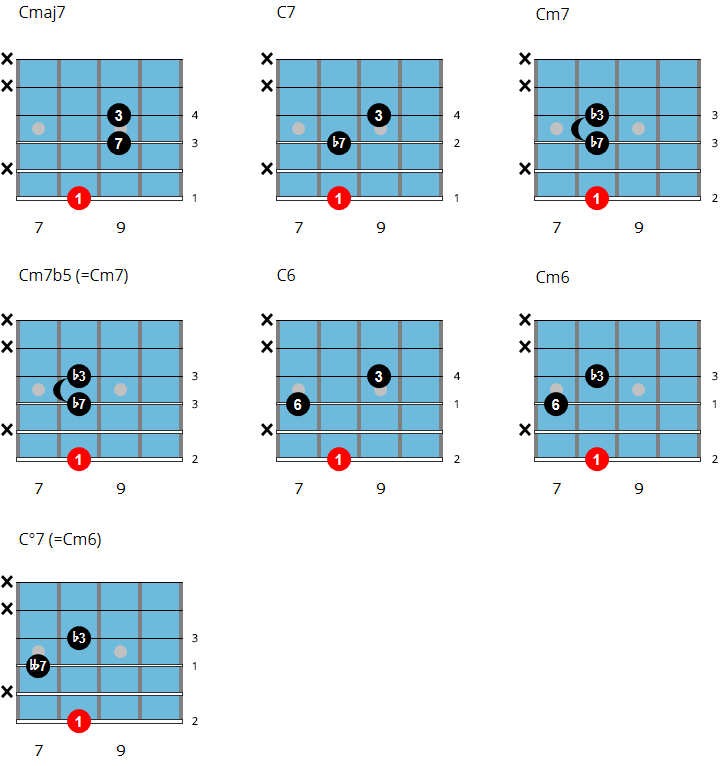
1 3 7 Shell Chords (A-String Root)

1 7 3 Shell Chords (A-String Root)
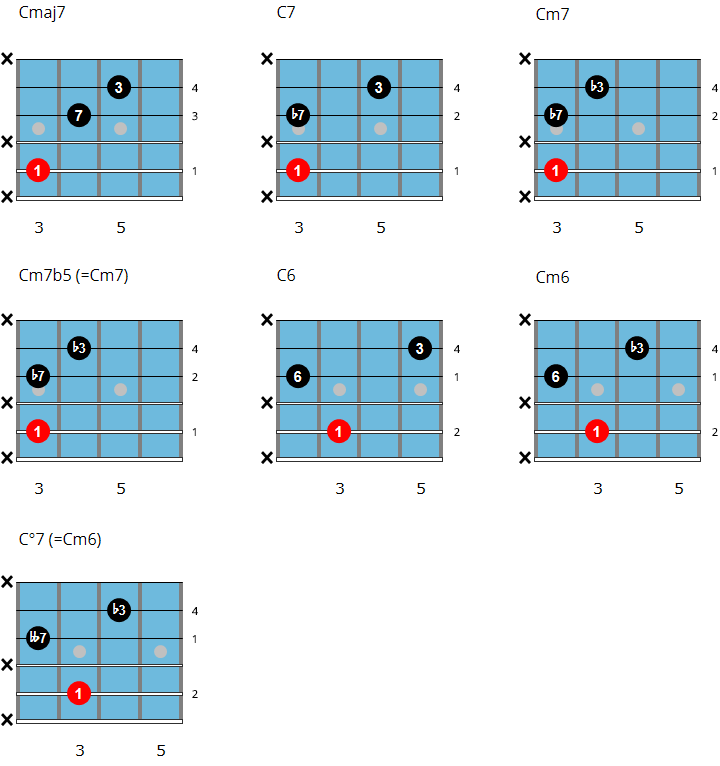
3. Chords with Extensions
Extended chords use intervals outside of the root, 3rd, 5th, and 7th in their construction.
Because of this, we often describe these chords as more “colorful“ compared to more basic jazz guitar chords.
Because we don’t have 10 fingers to play chords as a pianist would do, guitarists have to leave some notes out when adding extended notes to their chord shapes.
Keep that in mind, and notice which notes are replaced as you add these fun chord shapes to your harmonic vocabulary.
Major 6 chords and major 6(9) chords, the first two types of extended chords in this set, are different from the extended chords that follow because they don’t contain a 7.
All the other extended chords (such as maj9), contain the 7th in their construction.
In a major 6 chord, the 6 replaces the 7:
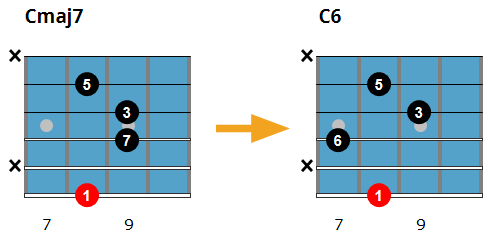
When a 6 and a 7 are both present in a major chord, it becomes a major 13 chord. Major 13 chords contain both the 7 and the 6 (=13), as opposed to major 6 chords, where the 7 is omitted.
Major 6 Chords

Major 6(9) Chords
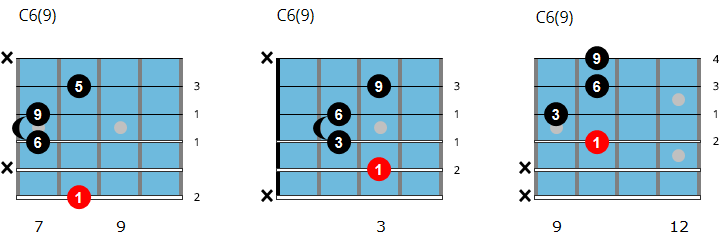
Major 9 Chords
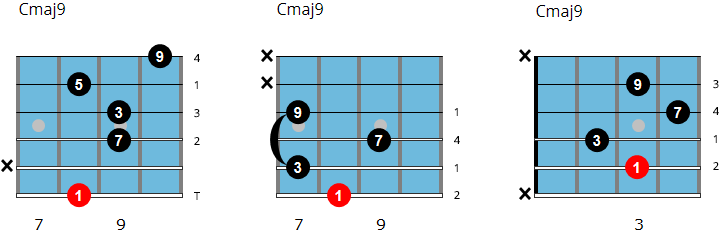

Major 13 Chords

Major 7#11 Chords
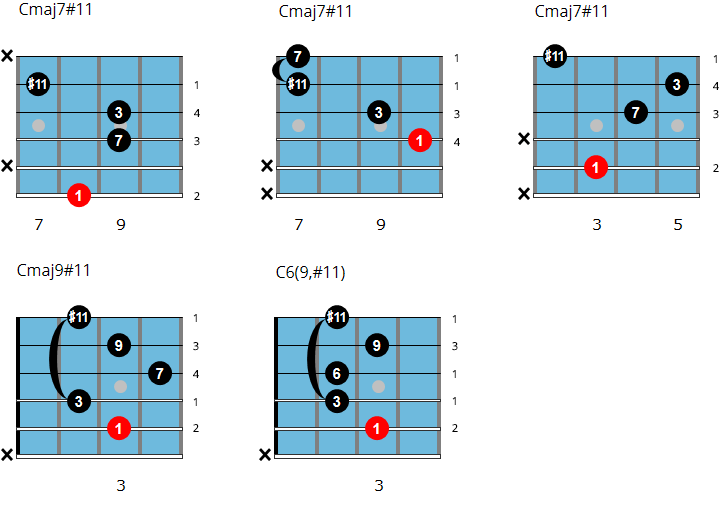
Major Augmented (Major #5) Chords
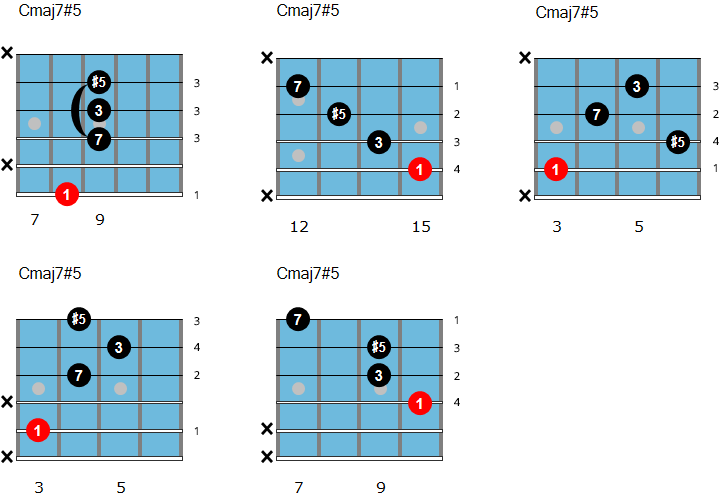
Dominant 9 Chords

Dominant 13 Chords

7 Sus 4 Chords

9 Sus 4 Chords
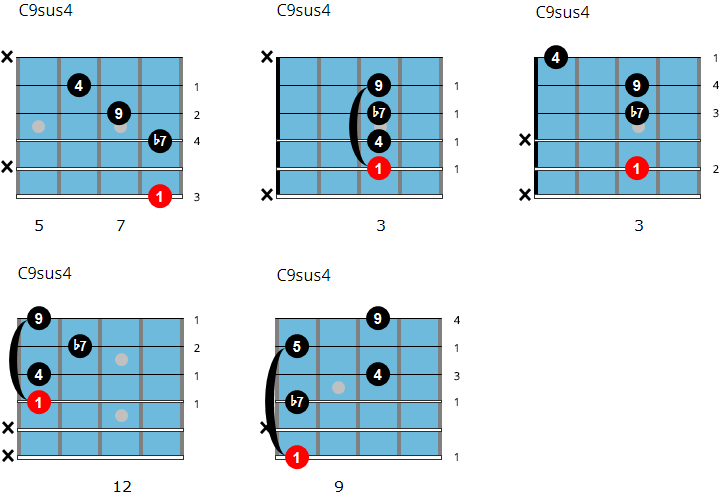
13 Sus 4 Chords

Minor 6 Chords
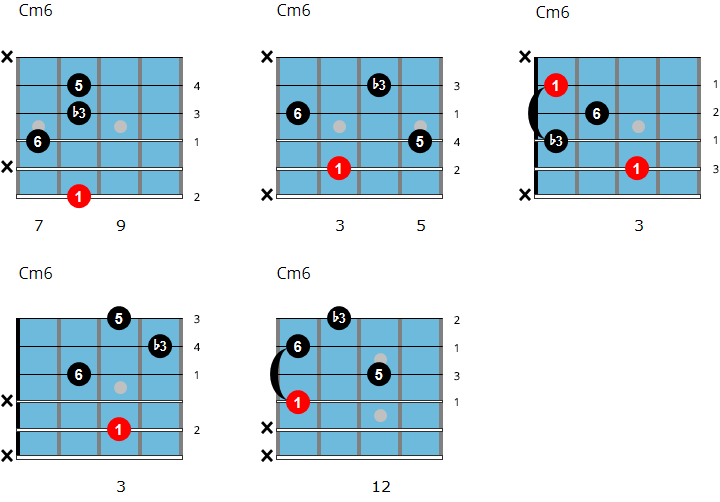
Minor 9 Chords
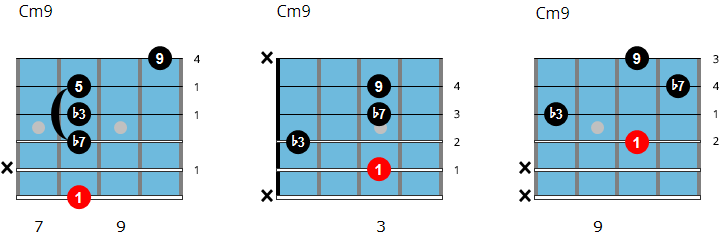
Minor 11 Chords

Minor/Major 7 Chords

Minor/Major 9 Chords

4. Dominant Chords with Altered Extensions
Besides the normal extensions (9-11-13), dominant chords can handle altered extensions as well, such as b9, #9, #11, and b13.
In this section you look at dominant chords with altered extensions.
These chords can be used over any dominant 7th chord in your comping to create extra tension, but if you’re new to these sounds start with using them in minor keys.
For example, if you have a minor ii V I chord progression (Dm7b5-G7-Cm7), you can use altered extensions over the G7 chord.
These extensions are supposed to sound tense and create tension, so if they sound “weird” to you, not a problem.
Work with them, and over time those outside notes will start to sound normal and more natural to your ears.
A lot of people are confused about the difference between extensions #11 and b5. Both are the same note, an f# (=gb) in C7.
A C7 with a #11 usually contains a natural 9 (d) because this chord is derived from the Lydian dominant scale (4th mode of the melodic minor scale). A C9#11 often functions as a bVII7 going to Imaj7 (C7#11 to Dmaj7, for example):

A C7 with a b5 contains a b9 or #9 because this chord is derived from the altered scale (7th mode of the melodic minor scale). A C7(b5,b9) often functions as a V7alt going to Im7 or Imaj7 (C7b5b9 going to Fm7 or Fm9, for example):
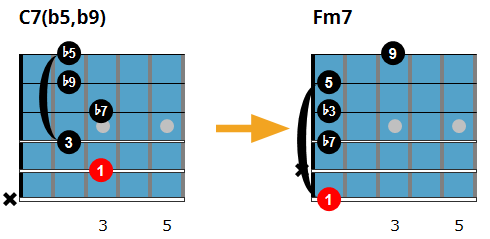
Dominant 7b9
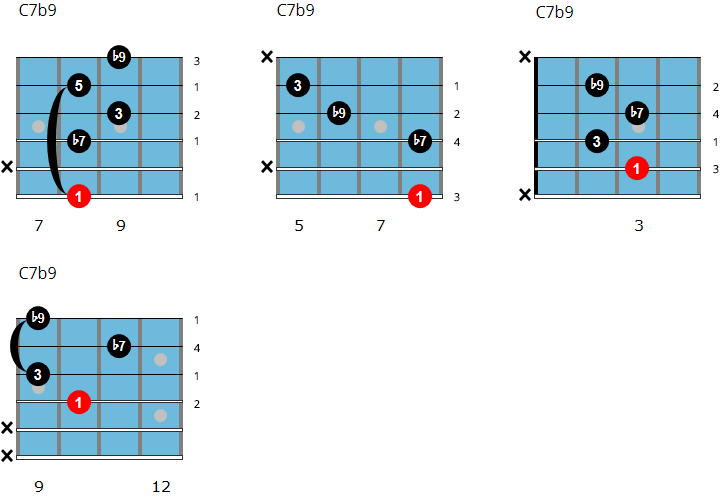
Dominant 7b9 Sus 4

Dominant 13b9 / Dominant 13#9


Dominant 7#9
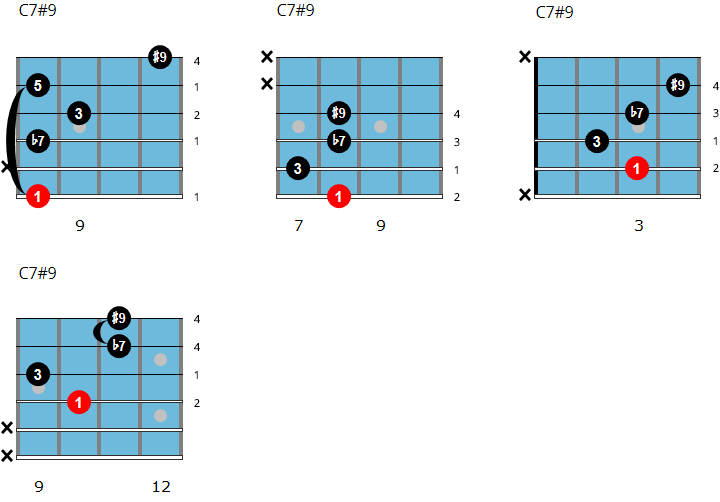
Dominant 7#11
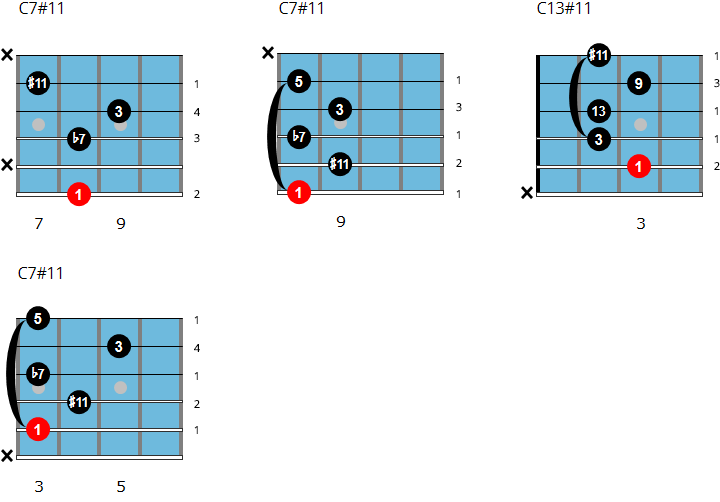
Dominant 7b13
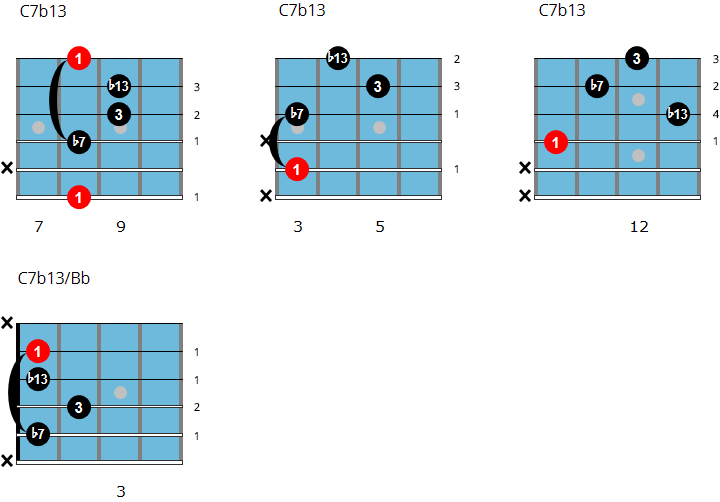
Altered – 7b5(b9)

Altered – 7b5(#9)

Altered – 7#5(b9)

Altered – 7#5(#9)

5. Chord Inversions
Chord inversions use other notes in the bass than the root note.
Notice that for each group of chords, the root is in the bass for the first chord shape, then the 3rd, 5th, and the 7th after that.
Each of these chord inversions can be applied to that chord in your comping. For example, if you see a Cmaj7 chord symbol you can play any inversion of Cmaj7.
Just know that each inversion will have a slightly different sound and some voicings will work better than others.
Though they use the same notes, putting the root or the 3rd in the bass causes the chord to have a slightly different flavor.
Major 7 Inversions (Drop 2) – A-String Bass Note

Major 7 Inversions (Drop 2) – D-String Bass Note

Major 7 Inversions (Drop 3) – E-String Bass Note

Major 7 Inversions (Drop 3) – A-String Bass Note

Dominant 7 Inversions (Drop 2) – A-String Bass Note

Dominant 7 Inversions (Drop 2) – D-String Bass Note

Dominant 7 Inversions (Drop 3) – E-String Bass Note

Dominant 7 Inversions (Drop 3) – A-String Bass Note

Minor 7 Inversions (Drop 2) – A-String Bass Note

Minor 7 Inversions (Drop 2) – D-String Bass Note

Minor 7 Inversions (Drop 3) – E-String Bass Note

Minor 7 Inversions (Drop 3) – A-String Bass Note

Minor 7b5 Inversions (Drop 2) – A-String Bass Note

Minor 7b5 Inversions (Drop 2) – D-String Bass Note

Minor 7b5 Inversions (Drop 3) – E-String Bass Note

Minor 7b5 Inversions (Drop 3) – A-String Bass Note

6. Open Chords
Open chords use open strings in their construction.
Though they are limited to a few keys, these shapes add new flavor to your comping in particular key centers. Open chords have a specific sound that is unique to the guitar.
Have fun with these open string chords and use them the next time you find yourself in one of these guitar-friendly keys.
Open Chords With E Root

Open Chords With A Root
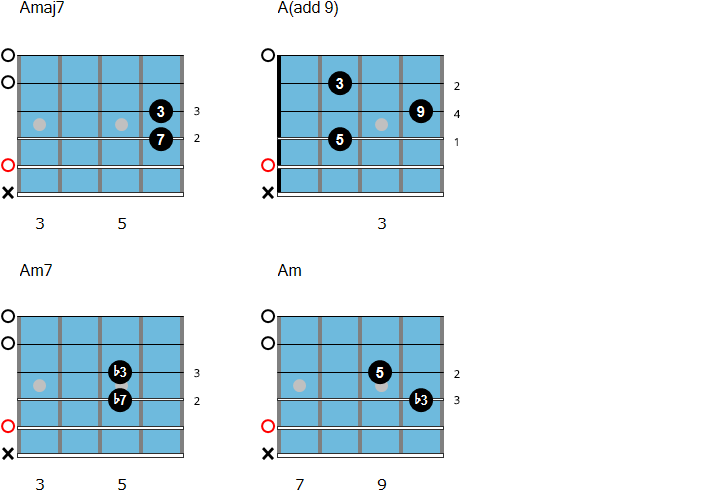
Open Chords With D Root

Open Chords With B Root

Open Chords With Bb Root

Open Chords With C Root

7. Quartal Chords
Quartal chords (aka 4th chords) are built by stacking 4th intervals above the lowest note of the chord.
These chords sound more open and modern compared to other chord types and can be used over any jazz standard in your comping and solos.
Give these chords a try and don’t worry if they sound a bit “too modern” in the beginning.
Over time they will become more natural to your ears and you will be able to apply these shapes to your playing more comfortably.
Quartal Chords Based on the C Dorian Scale (String Set 2-3-4-5)

Quartal Chords Based on the C Dorian Scale (String Set 1-2-3-4)



Thank you for posting your site!
This information is just Wonderful!
Kevin 🙂
This is really helpful. Thank you!!!
Great Resource, Dirk. Mucho Gracias!
easier to try and remember all the inversions
This is by far the most useful and comprehensive chord dictionary I’ve ever seen, something I was really looking for.
Great work, guys!
Many thanks!
Very nice job !!! Thanks
Thanks for this lesson! I am new to jazz and guitar harmony and this is very clarifying and a great guide to explore the essentials
Thanks, Dirk. I was building my own chord dictionary, off the net (from info on different sites). Now I’ve found them all here, concise, and in the one place. Very helpful, thanks again.
Hallo Dirk,
Lijkt mij erg leuk en interessant, deze download! (vind sowieso jullie info erg interessant; wanneer ik al niets nieuws leer, leer ik toch minstens dat dat wat ik weet klopte. Ook een vorm van leren en bevestiging 😉 )
Groetsels, Allard
Great info. You guys are the best.
This is an awesome resource! Thanks
Fantastic lesson incredable information thank you so much.
Thank you Dirk, really useful!
Molto interessante e completo questo piccolo manuale. Grazie Dirk, lo condivido nel mio gruppo FB !
Awesome! Thanks, Dirk! Was hoping for something like this. I have the Jazz Guitar Chords PDF, but this is more concise when you just want the chords. FYI, I found the below errors. The following headers in the article should say “A String Root” and not “E String Root” Thanks again!
Major 7 Inversions (Drop 2) – E String Root
Dominant 7 Inversions (Drop 2) – E String Root
Minor 7 Inversions (Drop 2) – E String Root
Minor 7b5 Inversions (Drop 2) – E String Root
Also, shouldn’t all the inversion headers say “* String Bass Note” and not “root”?
Hey Inland, you’re totally right, I fixed the errors. Thanks for letting me know!